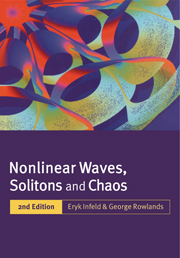Book contents
- Frontmatter
- Contents
- Foreword to the first edition
- Foreword to the second edition
- 1 Introduction
- 2 Linear waves and instabilities in infinite media
- 3 Convective and non-convective instabilities; group velocity in unstable media
- 4 A first look at surface waves and instabilities
- 5 Model equations for small amplitude waves and solitons; weakly nonlinear theory
- 6 Exact methods for fully nonlinear waves and solitons
- 7 Cartesian solitons in one and two space dimensions
- 8 Evolution and stability of initially one-dimensional waves and solitons
- 9 Cylindrical and spherical solitons in plasmas and other media
- 10 Soliton metamorphosis
- 11 Non-coherent phenomena
- Appendices
- References
- Author index
- Subject index
- Plate section
6 - Exact methods for fully nonlinear waves and solitons
Published online by Cambridge University Press: 05 June 2012
- Frontmatter
- Contents
- Foreword to the first edition
- Foreword to the second edition
- 1 Introduction
- 2 Linear waves and instabilities in infinite media
- 3 Convective and non-convective instabilities; group velocity in unstable media
- 4 A first look at surface waves and instabilities
- 5 Model equations for small amplitude waves and solitons; weakly nonlinear theory
- 6 Exact methods for fully nonlinear waves and solitons
- 7 Cartesian solitons in one and two space dimensions
- 8 Evolution and stability of initially one-dimensional waves and solitons
- 9 Cylindrical and spherical solitons in plasmas and other media
- 10 Soliton metamorphosis
- 11 Non-coherent phenomena
- Appendices
- References
- Author index
- Subject index
- Plate section
Summary
Introduction
In this chapter we will deal in some detail with the mathematical methods that can be used to treat fully nonlinear wave problems.
The best known single development of the last thirty years is the discovery of a method for solving the initial value problem for a limited class of nonlinear partial differential equations. This is the inverse scattering method (ISM). This method, however, proves difficult to extend to general initial conditions and is more useful for solitons than for waves. It will be presented in Chapter 7. There are, however, several other methods for dealing with nonlinear waves (often solitons also). They deserve notice in their own right. Some of them have been developed fairly recently. Few are limited to equations solvable by ISM. This chapter will concentrate on these methods as applied to nonlinear waves and solitons. We hope to give an idea of how rich the family of known nonlinear waves now is.
Thus this chapter and the next will concentrate on methods as illustrated by simple plasma physics, fluid dynamics and other problems. We will find the shapes of nonlinear waves and solitons without in principle assuming small amplitude. Where we do restrict considerations to small amplitude (Section 6.5) it will be done in the hope of extracting more information out of an exact method (Lagrangian description of fluid flow) than would otherwise be forthcoming. Yes, by restricting a formalism (small in place of general amplitude) we will learn more.
- Type
- Chapter
- Information
- Nonlinear Waves, Solitons and Chaos , pp. 123 - 165Publisher: Cambridge University PressPrint publication year: 2000



